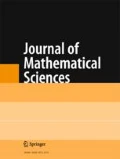Best simultaneous Diophantine approximations of Pisot numbers are obtained. To this end, the karyon approximation method is used. Approximation of Littlewood–Pisot numbers is investigated in detail.
Similar content being viewed by others
References
V. G. Zhuravlev, “Differentiation of induced toric tilings and multidimensional approximation of algebraic numbers,” Zap. Nauchn. Semin. POMI, 445, 33–92 (2016).
V. G. Zhuravlev, “Two-dimensional approximations by the method of dividing toric tilings,” Zap. Nauchn. Semin. POMI, 440, 81–98 (2015).
V. G. Zhuravlev, “Dividing toric tilings and bounded remainder sets,” Zap. Nauchn. Semin. POMI, 440, 99–122 (2015).
V. G. Zhuravlev, “Periodic karyon continued fraction expansions of cubic irrationalities,” Sovrem. Probl. Matem. (2016), in print.
Z. Coelho, A. Lopes, and L. F. Da Rocha, “Absolutely continuous invariant measures for a class of affine interval exchange maps,” Proc. Amer. Math. Soc., 123, No. 11, 3533–3542 (1995).
V. G. Zhuravlev and A. V. Shutov, “Derivaties of circle rotations and similarity of orbits,” Max Planck Institut für Math., Preprint Series, 62, 1–11 (2004).
M. Furukado, Sh. Ito, A. Saito, J. Tamura, and Sh. Yasutomi, “A new multidimensional slow continued fraction algorithm and stepped surface,” Exper. Math., 23, No. 4, 390–410 (2014).
M. Abrate, S. Barbero, U. Cerruti, and N. Murru, “Periodic representations for cubic irrationalities,” Fibonacci Quart., 50, No. 3, 252–264 (2012).
N. Murru, “On the periodic writing of cubic irrationals and a generalization of Rédei functions,” Int. J. Number Theory, 11, 779–799 (2015).
Sh. Ito, J. Fujii, H. Higashino, and Sh. Yasutomi, “On simultaneous approximation to (α, α 2) with α 3 + kα −1 = 0,” J. Number Theory, 99, 255–283 (2003).
Q. Wang, K. Wang, and Z. Dai, “On optimal simultaneous rational approximation to (ω,ω 2)τ with ω being some kind of cubic algebraic function,” J. Approx. Theory, 148, 194–210 (2007).
P. Hubert and A. Messaoudi, “Best simultaneous Diophantine approximations of Pisot numbers and Rauzy fractals,” Acta Arithm., 124, No. 1, 1–5 (2006).
N. Chevallier, “Best simultaneous Diophantine approximations of some cubic numbers,” J. Théor. Nombres Bordeaux, 14, No. 2, 403–414 (2002).
N. Chevallier, “Best simultaneous Diophantine approximations and multidimensional continued fraction expansions,” Moscow J. Comb. Number Theory, 3, No. 1, 3–56 (2013).
A. Ya. Khinchin, Continued Fractions [in Russian], 4th ed., Moscow (1978).
V. G. Zhuravlev, “Periodic karyon expansions of algebraic units in multidimensional continued fractions,” Zap. Nauchn. Semin. POMI, 449, 84–129 (2016).
J. Lagarias, “Best simultaneous Diophantine approximations. I. Growth rates of best approximation denomimators,” Trans. Amer. Math. Soc., 272, 545–554 (1982).
G. Kassels, Introduction to the Theory of Diophantine Approximations [Russian translation], Moscow (1961).
E. S. Fedorov, The Elements of the Study of Figures [in Russian], Moscow (1953).
G. F. Voronoi, Collected Works [in Russian], Vol. 2, Kiev (1952).
V. G. Zhuravlev, “Exchanged toric developments and bounded remainder sets,” Zap. Nauchn. Semin. POMI, 392, 95–145 (2011).
V. G. Zhuravlev, “Bounded remainder polyhedra,” Sovrem. Probl. Matem., 16, 82–102 (2012).
K. Mukunda, “Littlewood Pisot numbers,” J. Number Theory, 117, 106–121 (2006).
G. Rauzy, “Nombres algébriques et substitutions,” Bull. Soc. Math. France, 110, 147–178 (1982).
V. G. Zhuravlev, “Rauzy tilings and bounded remainder sets,” Zap. Nauchn. Semin. POMI, 322, 83–106 (2005).
Author information
Authors and Affiliations
Corresponding author
Additional information
Translated from Zapiski Nauchnykh Seminarov POMI, Vol. 449, 2016, pp. 168–195.
Rights and permissions
About this article
Cite this article
Zhuravlev, V.G. Karyon Expansions of Pisot Numbers in Multidimensional Continued Fractions. J Math Sci 225, 950–968 (2017). https://doi.org/10.1007/s10958-017-3507-0
Received:
Published:
Issue Date:
DOI: https://doi.org/10.1007/s10958-017-3507-0


